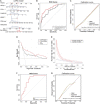Early plasma proteomic biomarkers and prediction model of acute respiratory distress syndrome after cardiopulmonary bypass: a prospective nested cohort study
- PMID: 37528797
- PMCID: PMC10498873
- DOI: 10.1097/JS9.0000000000000434
Early plasma proteomic biomarkers and prediction model of acute respiratory distress syndrome after cardiopulmonary bypass: a prospective nested cohort study
Abstract
Background: Early recognition of the risk of acute respiratory distress syndrome (ARDS) after cardiopulmonary bypass (CPB) may improve clinical outcomes. The main objective of this study was to identify proteomic biomarkers and develop an early prediction model for CPB-ARDS.
Methods: The authors conducted three prospective nested cohort studies of all consecutive patients undergoing cardiac surgery with CPB at Union Hospital of Tongji Medical College Hospital. Plasma proteomic profiling was performed in ARDS patients and matched controls (Cohort 1, April 2021-July 2021) at multiple timepoints: before CPB (T1), at the end of CPB (T2), and 24 h after CPB (T3). Then, for Cohort 2 (August 2021-July 2022), biomarker expression was measured and verified in the plasma. Furthermore, lung ischemia/reperfusion injury (LIRI) models and sham-operation were established in 50 rats to explore the tissue-level expression of biomarkers identified in the aforementioned clinical cohort. Subsequently, a machine learning-based prediction model incorporating protein and clinical predictors from Cohort 2 for CPB-ARDS was developed and internally validated. Model performance was externally validated on Cohort 3 (January 2023-March 2023).
Results: A total of 709 proteins were identified, with 9, 29, and 35 altered proteins between ARDS cases and controls at T1, T2, and T3, respectively, in Cohort 1. Following quantitative verification of several predictive proteins in Cohort 2, higher levels of thioredoxin domain containing 5 (TXNDC5), cathepsin L (CTSL), and NPC intracellular cholesterol transporter 2 (NPC2) at T2 were observed in CPB-ARDS patients. A dynamic online predictive nomogram was developed based on three proteins (TXNDC5, CTSL, and NPC2) and two clinical risk factors (CPB time and massive blood transfusion), with excellent performance (precision: 83.33%, sensitivity: 93.33%, specificity: 61.16%, and F1 score: 85.05%). The mean area under the receiver operating characteristics curve (AUC) of the model after 10-fold cross-validation was 0.839 (95% CI: 0.824-0.855). Model discrimination and calibration were maintained during external validation dataset testing, with an AUC of 0.820 (95% CI: 0.685-0.955) and a Brier Score of 0.177 (95% CI: 0.147-0.206). Moreover, the considerably overexpressed TXNDC5 and CTSL proteins identified in the plasma of patients with CPB-ARDS, exhibited a significant upregulation in the lung tissue of LIRI rats.
Conclusions: This study identified several novel predictive biomarkers, developed and validated a practical prediction tool using biomarker and clinical factor combinations for individual prediction of CPB-ARDS risk. Assessing the plasma TXNDC5, CTSL, and NPC2 levels might identify patients who warrant closer follow-up and intensified therapy for ARDS prevention following major surgery.
Trial registration: ClinicalTrials.gov NCT04696172.
Copyright © 2023 The Author(s). Published by Wolters Kluwer Health, Inc.
Conflict of interest statement
The authors declared that they have no conflicts of interest.
Sponsorships or competing interests that may be relevant to content are disclosed at the end of this article.
Figures






Similar articles
-
[Predictive value of postoperative serum procalcitonin concentration for moderate to severe acute respiratory distress syndrome in patients undergoing cardiopulmonary bypass surgery].Zhonghua Wei Zhong Bing Ji Jiu Yi Xue. 2023 May;35(5):487-492. doi: 10.3760/cma.j.cn121430-20211122-01760. Zhonghua Wei Zhong Bing Ji Jiu Yi Xue. 2023. PMID: 37308228 Chinese.
-
Comparison of Two Modern Survival Prediction Tools, SORG-MLA and METSSS, in Patients With Symptomatic Long-bone Metastases Who Underwent Local Treatment With Surgery Followed by Radiotherapy and With Radiotherapy Alone.Clin Orthop Relat Res. 2024 Dec 1;482(12):2193-2208. doi: 10.1097/CORR.0000000000003185. Epub 2024 Jul 23. Clin Orthop Relat Res. 2024. PMID: 39051924
-
Does the Presence of Missing Data Affect the Performance of the SORG Machine-learning Algorithm for Patients With Spinal Metastasis? Development of an Internet Application Algorithm.Clin Orthop Relat Res. 2024 Jan 1;482(1):143-157. doi: 10.1097/CORR.0000000000002706. Epub 2023 Jun 12. Clin Orthop Relat Res. 2024. PMID: 37306629 Free PMC article.
-
Pulmonary artery perfusion versus no pulmonary per-fusion during cardiopulmonary bypass.Dan Med J. 2018 Mar;65(3):B5473. Dan Med J. 2018. PMID: 29510817
-
Pulmonary artery perfusion versus no perfusion during cardiopulmonary bypass for open heart surgery in adults.Cochrane Database Syst Rev. 2018 Feb 8;2(2):CD011098. doi: 10.1002/14651858.CD011098.pub2. Cochrane Database Syst Rev. 2018. PMID: 29419895 Free PMC article.
Cited by
-
The role of coagulopathy and subdural hematoma thickness at admission in predicting the prognoses of patients with severe traumatic brain injury: a multicenter retrospective cohort study from China.Int J Surg. 2024 Sep 1;110(9):5545-5562. doi: 10.1097/JS9.0000000000001650. Int J Surg. 2024. PMID: 38752515 Free PMC article.
-
A commentary on 'Early plasma proteomic biomarkers and prediction model of acute respiratory distress syndrome after cardiopulmonary bypass: a prospective nested cohort study'.Int J Surg. 2024 Aug 1;110(8):5138-5139. doi: 10.1097/JS9.0000000000001477. Int J Surg. 2024. PMID: 38781041 Free PMC article. No abstract available.
-
MOTS-c attenuates lung ischemia-reperfusion injury via MYH9-Dependent nuclear translocation and transcriptional activation of antioxidant genes.Redox Biol. 2025 Jul;84:103681. doi: 10.1016/j.redox.2025.103681. Epub 2025 May 15. Redox Biol. 2025. PMID: 40403491 Free PMC article.
-
Proteomic analysis of plasma and duodenal tissue in celiac disease patients reveals potential noninvasive diagnostic biomarkers.Sci Rep. 2024 Dec 2;14(1):29872. doi: 10.1038/s41598-024-80391-5. Sci Rep. 2024. PMID: 39622892 Free PMC article.
-
Transpulmonary LOX-1 Levels Are Predictive of Acute Respiratory Distress Syndrome After Cardiac Surgery: A Proof-of-Concept Study.Biomedicines. 2025 Mar 26;13(4):800. doi: 10.3390/biomedicines13040800. Biomedicines. 2025. PMID: 40299349 Free PMC article.
References
-
- Bronicki RA, Hall M. Cardiopulmonary bypass-induced inflammatory response: pathophysiology and treatment. Pediatr Crit Care Med 2016;17:S272–S278. - PubMed
-
- Stephens RS, Shah AS, Whitman GJ. Lung injury and acute respiratory distress syndrome after cardiac surgery. Ann Thorac Surg 2013;95:1122–1129. - PubMed
-
- Rubenfeld GD, Caldwell E, Peabody E, et al. . Incidence and outcomes of acute lung injury. N Engl J Med 2005;353:1685–1693. - PubMed
MeSH terms
Substances
Associated data
LinkOut - more resources
Full Text Sources
Medical
Miscellaneous

